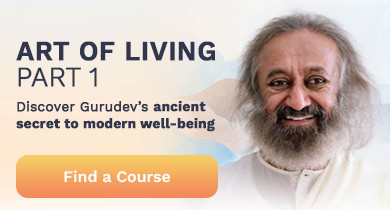
"Shiva is a state of meditation where there is nothing but the inner sky of consciousness." - Gurudev
When I first came across Shiva, I was confused. Here was an ascetic figure seated on a tiger skin with a blue throat, a third eye, and a moon perched on his head. What did this otherworldly form mean?
At other times, Shiva was explained as pure consciousness.
So which of these two was true? Or were they both perhaps two sides to one story?
Welcome to an exploration of the Shiva principle with Gurudev Sri Sri Ravi Shankar.
The experience of Shiva
Shiva is a space of deep silence and stillness where all the activities of the mind dissolve. This space is available wherever you are. The moment you are centered, you see that there is Divinity present everywhere. This is what happens in meditation.
Shiva is the fourth state of consciousness—the meditative state that is beyond the states of waking, deep sleep, and dreams.
Shiva is the consciousness that is non-dual and present everywhere.
Shiva is the consciousness that is pure bliss, called chidanandarupa.
There is a line in Sanskrit which says that this blissful, innocent state of consciousness, or Shiva, can be known through forbearance and yoga, tapo-yoga-gamya. Without yoga, Shiva can’t be experienced.
Yoga doesn’t just mean postures. It means the experience of this consciousness through meditation and breathing practices.
What is meditation?
The need to meditate is present in every human being because it is a natural tendency of human life to look for a joy that doesn’t diminish and a love that doesn’t turn into negative emotions. Meditation is a tool to reach such a state.
Human beings are gifted with a beautiful mind. It is through this mind that we think, perceive, analyze, and make decisions. Just as all these skills are natural to the human mind, so is meditation.
Meditation is the delicate and effortless art of doing nothing. It is the skill to take a deep rest while being conscious and alert. Beyond all the chatter and noise in our minds, there is a silent, peaceful, blissful, and beautiful space that exists in us all. A place that is intact and unbroken. Turning our attention to this silent chamber within is meditation.
Experiencing this silent space cleanses the mind, giving it a much-needed rest. This makes room for better perceptions and new ways of looking at life and its challenges.
Would you like to join a live instructor for a free introduction to meditation? Click here.
An ancient chant: “Om Namah Shivaya”
When someone insults you, how do you feel?
If someone were to call you a donkey, how would you feel? What does it do to you? What feeling does it create?
Anger! It shakes you. This sound has created some negative vibrations, and you feel angry. You may feel some sensations in the stomach and the head. If a bad word can create so many physiological reactions in you, what do you think a sweet chant can do for you?
Mantras
Mantras are energizing sounds that help to uplift consciousness and subtle energy. Mantras are those sounds that you hear from deep within during meditation. The aim of these sounds is to bring one back to the source.
Different mantras have certain vibrations and energy. People have been chanting "Om Namah Shivaya" for thousands of years. It is one of the most powerful mantras. It is made of five sounds, "Na-mah-shi-va-ya." These five syllables symbolize the five elements in creation—earth, water, fire, air, and space. The five elements are the building blocks of everything in creation, including the human body.
"Om" represents the life force and has many meanings. "Om" means peace and love. The life energy present in all the elements is represented by this mantra, "Om Namah Shivaya." So "Om Namah Shivaya" chanting is done to harmonize the five elements in the environment. When there is peace, love, and harmony in all the five elements, there is joy.
Guided meditation: Om Namah Shivaya
The symbolism of Shiva
There is a rich tradition in India where this silent space of innocence and bliss is depicted in brilliant forms and colors. Let's look at the art that attempts to paint the formless with line and symbol. What are the symbols and what do they mean?
As Gurudev shares, "Shiva doesn’t have a body. He was never a person at all. The ancient rishis made a form to symbolize the unfathomable divinity and to make it comprehensible for children and others."
Shiva's blue skin
Blue means infinite like the sky. Blue signifies the all-pervading infinity which has no limits and no shape. Knowledge has no shape, but it exists in each and every particle of the universe. The whole world is filled with Shiva. Hence blue was used to represent infinity.
The crescent moon
Wisdom is beyond the mind, but it needs a tinge of mind to be expressed. This is what is symbolized by the crescent moon.
The Shiva experience is where there is "no-mind." The moon signifies the mind. When there is "no-mind," how can this state be expressed? In the manifest world, the infinite consciousness requires a little bit of mind to express itself. So the crescent moon symbolizes that little bit of mind that is required to express the inexpressible.
Shiva's bull
In India, the bull has been used as a symbol of righteousness for a long time. The form of Shiva depicted riding on the bull simply means that when you are righteous and truthful, the infinite, innocent consciousness resides with you.
The third eye
Shiva's third eye represents the knowledge that is beyond the reach of the senses. One kind of knowledge is that which we receive through our sense organs, and the other kind is the knowledge that is beyond the limited perception of the senses, represented by the third eye. The third eye is the seat of knowledge and awakened wisdom.
Shiva's drum, the damru
Shiva's drum, called damru, symbolizes the universe, which is always expanding and collapsing. From expansion, it collapses, and then it re-expands. This is the process of creation and destruction. If you see your heartbeat, it is not just one straight line. It is a rhythm that goes up and down.
The whole world is nothing but rhythm—energy rising and collapsing only to rise again.
The damru signifies this cosmic rhythm and the non-dual nature of life and the universe.
River Ganga
The River Ganga, or Ganges, is seen to flow downward from Shiva's matted hair. What does the Ganges mean here?
The River Ganges symbolizes knowledge—the type of knowledge that purifies your soul. The head symbolizes knowledge, and the heart means love. The Ganges is shown flowing down from the matted hair on Shiva’s head. If the River Ganges were love, it should have come out of Shiva's heart. However, the water comes down from the head, meaning knowledge.
Knowledge liberates. It brings freedom. It purifies.
Tiger skin seat
In ancient days, ascetics used to use the skins of animals who had died naturally, not by killing them. Today there are comfortable cushions available, while in ancient times there were not. So they used to sit on animal skins to prevent their energy from escaping into the ground. However, it is not necessary to sit on animal skins. Just imagine if everyone who meditates these days started to use deer or tiger skins, there wouldn't be enough of them for everybody!
The snake
Shiva is a state of meditation where there is nothing but the inner sky of consciousness.
In this state there is alertness without action.
This state of meditation when the eyes are closed gives the impression that the person is sleeping. However, he is not asleep, but alert.
To symbolize this alertness and express this state of consciousness, the form of the snake is depicted around Shiva’s neck.
The trident
Shiva's trident represents three states of consciousness, waking, dreaming, and sleep. Holding a trident signifies that the state of Shiva is beyond all three states, yet it also encompasses these three states.
Shiva's trident also represents the three gunas, or qualities of positivity, activity, and rest (sattva, rajas, and tamas). Consciousness is beyond the three qualities, but it also holds the three together.
Shiva's dance
The Creator and the creation are one and the same. Creation is formed out of the creator, just like dance comes out of the dancer.
One beautiful form that has been given to Shiva is a figure shown dancing in absolute bliss, called Nataraja. The essence behind this image is so unique and beautiful.
One of Shiva's hands in the dance is placed in the gesture of fearlessness, called abhaya mudra. It means there is nothing to fear. Be free of worries. Be happy.
The other hand reaches across and bends slightly downwards, pointing to the feet in the dance. What does that mean? It means: Dance! Rejoice and celebrate! Be humble in life, but also walk confidently with your head held high. One who is arrogant is not necessarily free from fear. So it means to be free from fear without becoming stiff with ego; it means to be simple and natural. It is also a reminder that you have everything that you need.
This is the deeper meaning behind the representation of Shiva in blissful dance.
Also, the whole universe is itself the dance of one consciousness. The one consciousness dances, and that dance is the manifestation of nature in all its variety and splendor. So this infinite creation is the dance of consciousness. Shiva is that in which everything in the universe has taken birth and which encompasses everything.
Another dimension to the dance of consciousness
Our life is composed of different levels and is not experienced at just one level alone. Scientists today say that our brain is a frequency analyzer. For example, if you set your television to a particular channel, then you see and hear only that channel. When we change the channel, then we see and experience another channel. Our brain works in a similar way to the TV and its channels.
We are tuned into and live in one particular channel, and that channel is this world. When we change the channel, we tune into an altogether different dimension. That dimension is the subtle world, and in this subtle world, there is a constant dance of consciousness.
Fire in hand
In the palm of one hand, the dancing form holds a flame. Here, the fire element represents shakti, the totality of energy in the universe. This energy is held within space and consciousness.
Shiva linga
Linga means identification, a symbol through which you can identify what the reality is. When a baby is born, how do you know its gender? You can identify whether the baby is a boy or a girl only through one part of the body. That’s why in India the genital is also called "linga".
Now how do you identify the Creator? He has no form!
So then, in India the ancient sages said that there should be a sign to identify Divinity. So the sign became the Shiva Linga. Shiva Linga is ancient. Through the Shiva Linga, from the form you go to the formless. It is a symbol that represents the cosmos and the creator of the cosmos as one. It is the two principles in creation—the silent, unmanifested consciousness and the dynamic manifestation of the universe in a single form together.
The forms of the formless
The various forms are a language of symbols. Like words seek to express something beyond language, these forms hint at the infinite consciousness that is omnipresent, yet formless.
An Ancient Practice: The Night of Shiva, Shivaratri
The night of Shiva, called Shivratri, is to remind oneself of the non-dual reality which is the very basis of this entire creation.
Shivratri is when you repose in your being. The night gives you comfort. However frustrated you are, when you sleep you are not touched by frustration. Sleep relieves you of pain, suffering, frustration, desires, and fears. There are none of these emotions in sleep because it relieves you from all this. It comforts you.
When we are awake, we are so busy. We are caught up in so many things. And when we are tired, we fall asleep and get into inertia. But there is something in between.
Discovering rest with awareness
When you consciously repose in your being, you encounter that which is magnificent, that which is universal, that which has no boundaries, that which has no time. Shiva is beyond time and yet is called the grand time.
When you meditate what do you feel? You feel the timelessness. When you take a dip in the empty space that you are, you find that emptiness is full of all bliss.
We get so fried by our desires, fears, anxieties, wants, and dislikes. We need rest. That rest is what meditation is, and it is meditation that leads us to the experience of the Shiva principle. For a moment you see that the entire phenomenal world is ephemeral, like a dream. The dream nature of everything in the world lifts you to the reality that you are.
You are that vast consciousness, which has no limits.
Anything that bothers you, you simply have to let go.
Infinity in opposites
Shiva is personal, yet universal.
Shiva is beauty, yet unseen.
Shiva is in every particle in all that we see; what is unseen is also Shiva.
It is the night that gives you the vision of infinity. At night, you glimpse the vastness of the universe. The glory of existence is exhibited at night.
Just as night takes you on its lap and soothes you from every emotion, good or bad, in the same way deep meditation brings you relief and uplifts you.
That is what Shivaratri is about: to be awake inside and repose in yourself.
Every Shivaratri is a wake-up call to move away from conflict and towards truth, beauty, peace, and benevolence, the qualities of Shiva.
The Shiva Sutras
An ancient text on how to live in joy
Rainy days are a part of life. These periods often test your inner strength, giving you a chance to come out of them shining. The Shiva Sutras are ancient aphorisms that help you surmount any negativity. They change the mind’s tendency to hold on to the negative and overlook the positive. They connect us with the three aspects of Shiva within us:
Truth, Satyam
Innocence, Shivam
Beauty, Sundaram
They uplift you to these aspects even when life is not rosy.
A Sutra is a thread. If someone has fallen in a deep well, what do you do? You throw a rope at them. They hold on to the rope and come up. You pull them up. That is what the Shiva Sutras are meant to do. These are simple one-line sutras, which are there to make you aware that your true nature is bliss, your true nature is joy and light.
It is said in the Upanishads, “Life happens in joy and finds completion in joy.” That the soul should be filled with happiness is the goal of the Shiva Sutras.
Conclusion
What is Shiva? Rather, what is not Shiva?
Shiva is a state where there is nothing but the inner sky of consciousness. How can we feel first hand such a state of restful awareness, free from negativity? Through practices of breathing and meditation, through chant and yoga.
Enjoy a free introduction to meditation and breathwork with a certified instructor through the link below.































